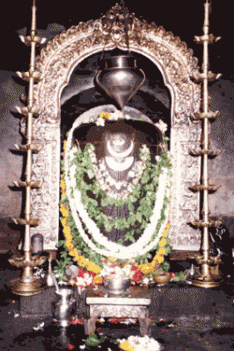Udyaneshwar Siva Temple


This temple dedicated to Lord Siva is situated on the North Eastern side of the Theppakulam of Cochin Thirumala Devaswom. As per the legend, the gigantic lingom of the temple belonged to an ancient temple, Thrikkannamathilakom, about thirteen miles from Irinjalakuda in Trichur District. Thrikkanna Mathilakom became famous at a later stage for being the site of a famous siva temple to which many other temples of Kerala such as Guruvayur and Koodalmanikyam are thought to have been once subordinate. The lingom of the Deity of the Mathilakom temple is said to have been installed by Parasurama for the benefit of 64 villages of Namboothiri Brahmins. The boundary wall of the temple is extended to Teppekulam in the north and Naranjerikulam in the South. Teppekulam is a beautiful pond filled with lotuses of different colours where the priests’ bath daily .On the Western side of the temple, there is another pond called Chempalikulam. The early rulers of Kerala, the perumals used to held their parliament in the upper floor of the tank shed of Chempalikulam. The daily offering of Udayaneswar Siva consist of nivedya prepared from 101 measures (paras) of rice. The management of the affairs of the Mathilakom temple was rested with the two Nair families of Thekkedath and Vadakkedath. After assuming the full management of the mathilakom temple, they decided to construct six more walls around the temple to allow people of different castes to occupy each enclosure. As per the plan, the outermost wall would have extended into the sanketham of the Brahmins of Irinjalakuda gramam. They protested against the decision of the Nairs; but the protests were dealt with firmly and the namboodiries were imprisoned and those who protested by lying down in the trenches were brutally beaten up. Orders were given to build the foundation over the bodies of those who dare to remain in the trenches. Running out of all options, namboodiries decided to perform a homa, which was attended by brahmins from all over Kerala. A sumptuous feast was prepared and as they were about to be served, one man stood up and asked the gathering not to touch even a single morsel of food till their objective is met. Immediately they gathered around the sacrificial fire pit and all the food items were thrown into it to the accompaniment of chants and prayers for the destruction of their enemies. They also undertook a fasting for 41 days during which they ate only fruits. True to the prayers of the namboodiries, the Nair chieftains quarrelled among themselves, which led to the decline of the two Nair families along with the legendary Mathilakom temple. The namboodiries gave up living in the village where the temple of Siva of Mathilakom existed as it happened to be the place that they cursed. The temple fell into ruins. In the 14th century, mathilakom came in the possession of Zamorin of Calicut. However in 1717 AD, The Dutch got the sovereignty of this place from the ruler of Calicut. The Dutch moved the siva lingam along with many other relics of the temple to their head quarters of Fort Cochin. The Sivalingam was used as a mooring on the seashore of Fort Cochin for the lighters that carry cargo to ships. When the Dutch surrender to the British in 1795, the Konkanis in Cocohin bough this sacred sivalingam and decided to install it at a site, north east of T D Tappekulam amidst a garden. As there was no scope of constructing a massive temple that can accommodate this huge lingam that is said to be of 21 feet in height, it was installed with a major part of it under the earth. Now the lingam is visible only about 4.5 ft above the ground level and the arrows that are seen on the lingam resemble the lines that are seen on one of the lingams installed in the famous siva temple at Perur , Tamil Nadu. Udayaneswara is also offered the same nivedhyam as Lord Venkateswara Thirumala temple in Cochin. Lord Udayaneswara faces west facing the Arabian sea unlike the other siva temples where the linga typically faces towards the East. Every Monday, the lamp post in front of the temple is illuminated. Mahasivarathri festival that falls in February- March is the main festival of this temple. Some of the other important offerings in this temple are Rudrabhishikem , pushpanjali, Rudra havanam, Bilvarchana and chandana lepanam among others. It is believed that young unmarried ladies get suitable husbands by performing Swayamvara Pushpanjali. During the Aarattu festival in Thirumala Devaswom , the image of the deity is carried in procession on a horse driven vehicle from the main temple to Udyaneswara temple, where Lord Shiva also joins the palli vettai before returning to the main temple.






